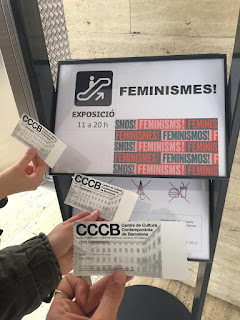Dana Fernandez, Andor Folch, Maria Muñoz, Eira Roca, Candela Serrano & Emma Sierra
ARTISTIC ACTIVITY IN THE CCCB MUSEUM!
CONTEXT OF THE ACTIVITY
We are going to the CCCB Museum, in Barcelona, with the class of 6th of Primary to see the exhibition “Feminismes!”.
OBJECTIVES
- To promote kids autonomy
- To make students see that sex is something normal
- To normalize taboo topics
- To develop the artistic competence
KEYWORDS
Visual arts, taboo topic, creativity, critical spirit, human values, feminism, free mind, equality, sexuality.
ACTIVITY
The activity consist on the following. Children will visit the exhibition freely, paying attention to the works that composed it.
Once they finish the tour of the exhibition we will do an activity in a room of the museum. What we want children to do is to think about the piece of the exhibition that they liked the most, it does not matter why, but they have to represent what they felt, how they felt, what it has transmitted on them, etc.
We will give the pupils many types of materials in order for them to find the one which they express better with. For example they can do a drawing, a letter, paintings, sculptures, mockups, etc. Any kind of representation will be accepted.
When all the kids have their own representations, they will have to explain in front of all the clas why did they choose that piece of art of the exhibition and why did they represent it like that. The main goal is to create an open space where children can express their feeling while being listened by all the class.
Eventually, the teacher will do a final reflection about all the representations in general, asking deeper questions such as: Why do you felt like this? Do you think you have been influenced by the society in the way you think about the paintings? Did you feel uncomfortable when seeing some of the painting?...
MATERIALS
All the possible materials that the museum has in order to make children choose from a really wide variety. For example paint, sheets, markers, colours, paint brushes, etc.
PURPOSE
The main purpose of this, apart from what we have already said above, is the next. As they are growing up, this activity will be helpful to start introducing the taboo topic of sex.








